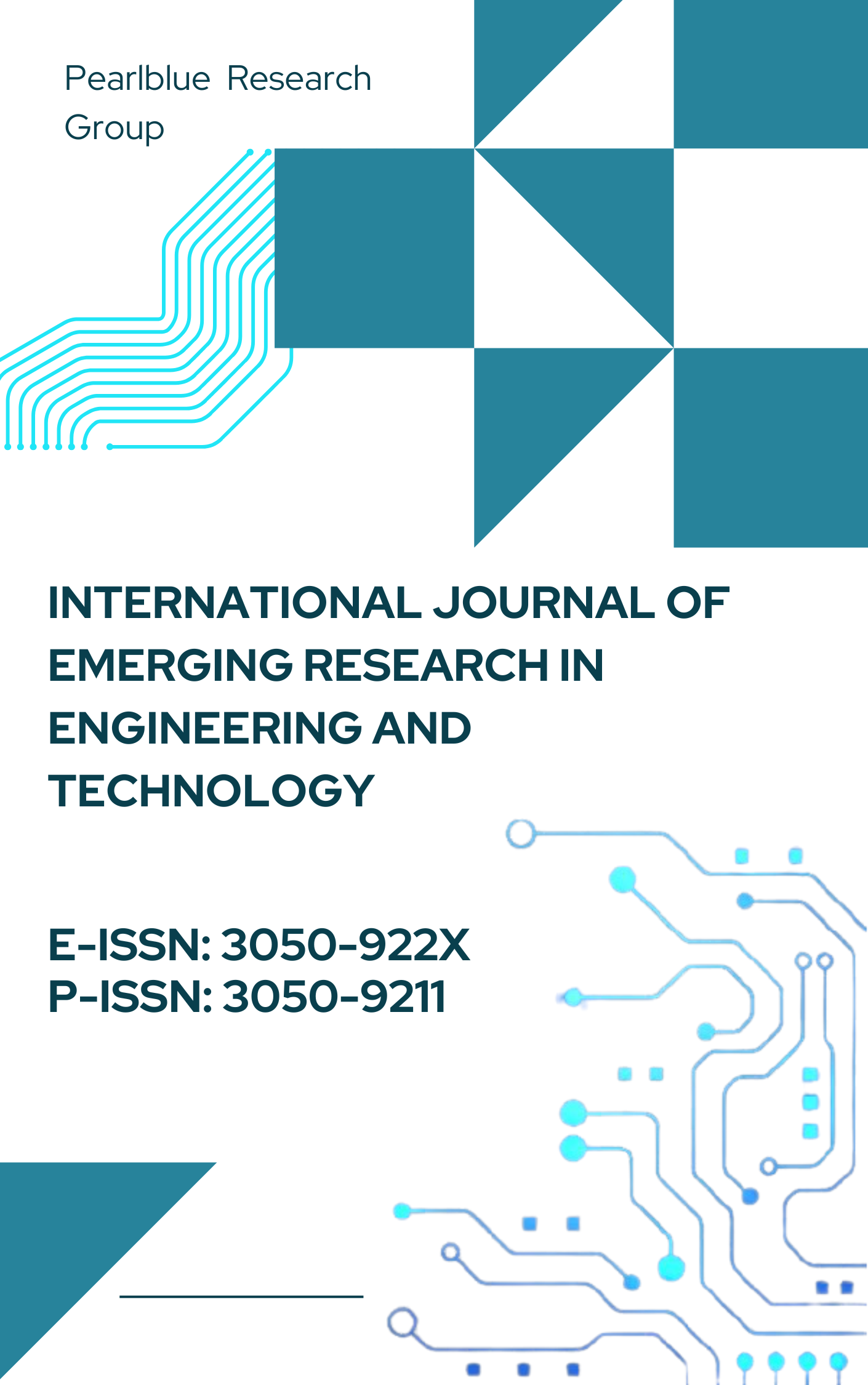Enhancing IoT (Internet of Things) Security Through Intelligent Intrusion Detection Using ML Models
DOI:
https://doi.org/10.63282/3050-922X.IJERET-V2I1P104Keywords:
Industrial Internet of Things (IOT), Smart Industry, Big Data Analytics, Real-time Monitoring, Digital TransformationAbstract
Through IoT technology wireless communications experience a fundamental transformation that reshapes various industries. Multiple cyberattacks exploit the limited capacity and broad exposure among IoT networks. IDS systems require advanced technologies because existing security systems fail to detect new potential threats. This research proposes Long Short-Term Memory (LSTM)-based deep learning models to develop an intelligent intrusion detection system (IDS) that improves IoT security. The LSTM model performs training on the ToN-IoT dataset data after applying multiple preparation steps, including cleaning and normalization and encoding different features. The model's remarkable detection skills are demonstrated by a number of evaluations, such as its 99.41% detection accuracy, 99.35% precision, 99.32% recall, and 99.33% F1-score. By employing an implemented LSTM model researcher could achieve higher classification success rates than a DBN model serves as validation for monitoring threat detection and temporal pattern measurement. The suggested method provides a strong, scalable, and flexible IoT intrusion detection solution, enhancing security for IoT settings that are becoming more intricate and networked
References
[1] J. King and A. I. Awad, “A distributed security mechanism for Resource-Constrained IoT Devices,” Inform., 2016.
[2] M. Hasan, M. M. Islam, M. I. I. Zarif, and M. M. A. Hashem, “Attack and anomaly detection in IoT sensors in IoT sites using machine learning approaches,” Internet of Things (Netherlands), 2019, doi: 10.1016/j.iot.2019.100059.
[3] E. Bertino, K. K. R. Choo, D. Georgakopolous, and S. Nepal, “Internet of things (IoT): Smart and secure service delivery,” ACM Trans. Internet Technol., 2016, doi: 10.1145/3013520.
[4] G. Thamilarasu and S. Chawla, “Towards deep-learning-driven intrusion detection for the internet of things,” Sensors (Switzerland), 2019, doi: 10.3390/s19091977.
[5] S. T. Bakhsh, S. Alghamdi, R. A. Alsemmeari, and S. R. Hassan, “An adaptive intrusion detection and prevention system for Internet of Things,” Int. J. Distrib. Sens. Networks, 2019, doi: 10.1177/1550147719888109.
[6] A. Ghosh, D. Chakraborty, and A. Law, “Artificial intelligence in Internet of things,” CAAI Trans. Intell. Technol., vol. 3, no. 4, pp. 208–218, Dec. 2018, doi: 10.1049/trit.2018.1008.
[7] M. F. Elrawy, A. I. Awad, and H. F. A. Hamed, “Intrusion detection systems for IoT-based smart environments: a survey,” Journal of Cloud Computing. 2018. doi: 10.1186/s13677-018-0123-6.
[8] A. Alshammari, M. A. Zohdy, D. Debnath, and G. Corser, “Classification Approach for Intrusion Detection in Vehicle Systems,” Wirel. Eng. Technol., 2018, doi: 10.4236/wet.2018.94007.
[9] J. hua Li, “Cyber security meets artificial intelligence: a survey,” Frontiers of Information Technology and Electronic Engineering. 2018. doi: 10.1631/FITEE.1800573.
[10] V. Kolluri, “A Comprehensive Analysis on Explainable and Ethical Machine: Demystifying Advances in Artificial Intelligence,” TIJER - Int. Res. Journals, vol. 2, no. 7, pp. 2349–9249, 2015.
[11] [11] J. Ordóñez, P. Ameigeiras, D. Lopez, J. Ramos, J. Lorca, and J. Folgueira, “Network Slicing for 5G with SDN/NFV: Concepts, Architectures and Challenges,” IEEE Commun. Mag., vol. 55, 2017, doi: 10.1109/MCOM.2017.1600935.
[12] D. Li, L. Deng, M. Lee, and H. Wang, “IoT data feature extraction and intrusion detection system for smart cities based on deep migration learning,” Int. J. Inf. Manage., vol. 49, no. October 2018, pp. 533–545, 2019, doi: 10.1016/j.ijinfomgt.2019.04.006.
[13] V. Kolluri, “A Pioneering Approach To Forensic Insights: Utilization AI for Cybersecurity Incident Investigations,” Int. J. Res. Anal. Rev., vol. 3, no. 3, 2016.
[14] P. Van Huong, L. D. Thuan, L. T. Hong Van, and D. V. Hung, “Intrusion detection in IoT systems based on deep learning using convolutional neural network,” in Proceedings - 2019 6th NAFOSTED Conference on Information and Computer Science, NICS 2019, 2019. doi: 10.1109/NICS48868.2019.9023871.
[15] M. Roopak, G. Y. Tian, and J. Chambers, “Deep Learning Models for Cyber Security in IoT Networks,” in 2019 IEEE 9th Annual Computing and Communication Workshop and Conference (CCWC), IEEE, Jan. 2019, pp. 0452–0457. doi: 10.1109/CCWC.2019.8666588.
[16] I. Alrashdi, A. Alqazzaz, E. Aloufi, R. Alharthi, M. Zohdy, and H. Ming, “AD-IoT: Anomaly detection of IoT cyberattacks in smart city using machine learning,” in 2019 IEEE 9th Annual Computing and Communication Workshop and Conference, CCWC 2019, 2019. doi: 10.1109/CCWC.2019.8666450.
[17] B. Roy and H. Cheung, “A Deep Learning Approach for Intrusion Detection in Internet of Things using Bi-Directional Long Short-Term Memory Recurrent Neural Network,” in 2018 28th International Telecommunication Networks and Applications Conference, ITNAC 2018, 2018. doi: 10.1109/ATNAC.2018.8615294.
[18] F. Ertam, I. F. Kilinçer, and O. Yaman, “Intrusion detection in computer networks via machine learning algorithms,” in IDAP 2017 - International Artificial Intelligence and Data Processing Symposium, 2017. doi: 10.1109/IDAP.2017.8090165.
[19] E. Hodo et al., “Threat analysis of IoT networks using artificial neural network intrusion detection system,” in 2016 International Symposium on Networks, Computers and Communications, ISNCC 2016, 2016. doi: 10.1109/ISNCC.2016.7746067.
[20] N. Shone, T. N. Ngoc, V. D. Phai, and Q. Shi, “A Deep Learning Approach to Network Intrusion Detection,” IEEE Trans. Emerg. Top. Comput. Intell., vol. 2, no. 1, pp. 41–50, 2018, doi: 10.1109/TETCI.2017.2772792.
[21] Kalla, D., & Samiuddin, V. (2020). Chatbot for medical treatment using NLTK Lib. IOSR J. Comput. Eng, 22, 12.
[22] Kuraku, S., & Kalla, D. (2020). Emotet malware a banking credentials stealer. Iosr J. Comput. Eng, 22, 31-41.



